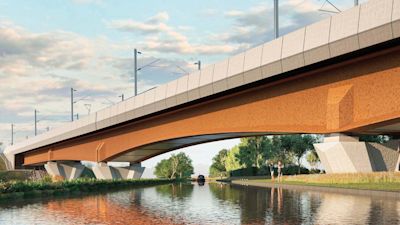New plans for wetland habitats around HS2’s Birmingham and Fazeley Canal viaduct

HS2’s designers have released updated designs for the land surrounding the section of the high-speed rail line that crosses the Birmingham and Fazeley Canal.
The Birmingham and Fazeley Canal viaduct is located north of HS2’s Delta Junction, a triangle-shaped series of viaducts that allows HS2 trains to travel between London, the Midlands, and the North.
The latest plans, developed by HS2 main works contractor, Balfour Beatty VINCI (BBV), respond to community feedback and include a series of wetlands containing four new ecological ponds, expansive grass meadows and approximately 22,000 m² of newly established woodland alongside the embankment to the north of the viaduct that is part of the green corridor planting - the equivalent of three football pitches.
A potential new public green space could be created to the south of the canal, with informal paths connecting the towpath to Seeney Lane.
There will be two species-rich ponds, seating and information boards encouraging wetland exploration and education.
The existing hedgerow running along the towpath will also be reinstated to maintain bat flight corridors along the canal; species-rich grasslands will provide homes for insects and bees; and new trees will screen views of the M42.
An ecological habitat to support biodiversity will also be created further north, including two ponds, planting zones and hedgerows to connect Cuttle Mill fishery and woodlands to the HS2 green corridor alongside the railway.
HS2 is planting up to 7 million trees as part of its extensive green corridor programme including species such as Silver Birch, Hazel, Hawthorne and Holly along the Phase One route between London and the West Midlands.
Over 220,000 trees have already been planted and 40 new ponds created in the West Midlands.